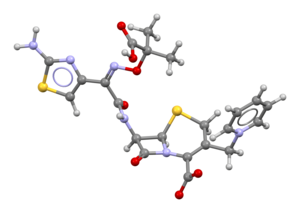 | |
 | |
| Clinical data | |
|---|---|
| Pronunciation | /sɛfˈtæzɪdiːm/ sef-TAZ-i-deem |
| Trade names | Fortaz, Tazicef, others[1] |
| AHFS/Drugs.com | Monograph |
| MedlinePlus | a686007 |
| License data |
|
| Pregnancy category |
|
| Routes of administration | Intravenous, intramuscular, inhalation |
| Drug class | Third-generation cephalosporin |
| ATC code | |
| Legal status | |
| Legal status | |
| Pharmacokinetic data | |
| Bioavailability | 91% (IM) |
| Metabolism | negligible |
| Elimination half-life | 1.6–2 hours |
| Excretion | 90–96% kidney |
| Identifiers | |
| |
| CAS Number | |
| PubChem CID | |
| DrugBank | |
| ChemSpider | |
| UNII | |
| ChEBI | |
| ChEMBL | |
| CompTox Dashboard (EPA) | |
| ECHA InfoCard | 100.069.720 |
| Chemical and physical data | |
| Formula | C22H22N6O7S2 |
| Molar mass | 546.57 g·mol−1 |
| 3D model (JSmol) | |
| |
| |
| | |
Ceftazidime, sold under the brand name Fortaz among others, is a third-generation cephalosporin antibiotic useful for the treatment of a number of bacterial infections.[1][5] Specifically it is used for joint infections, meningitis, pneumonia, sepsis, urinary tract infections, malignant otitis externa, Pseudomonas aeruginosa infection, and vibrio infection.[1] It is given by injection into a vein, muscle, or eye.[1][6]
Common side effects include nausea, allergic reactions, and pain at the site of injection.[1] Other side effects may include Clostridioides difficile diarrhea.[1] It is not recommended in people who have had previous anaphylaxis to a penicillin.[1] Its use is relatively safe during pregnancy and breastfeeding.[7] It is in the third-generation cephalosporin family of medications and works by interfering with the bacteria's cell wall.[1]
Ceftazidime was patented in 1978 and came into commercial use in 1984.[8] It is on the World Health Organization's List of Essential Medicines.[9] Ceftazidime is available as a generic medication.[1]
- ^ a b c d e f g h i "Ceftazidime". The American Society of Health-System Pharmacists. Archived from the original on 20 December 2016. Retrieved 8 December 2016.
- ^ "FDA-sourced list of all drugs with black box warnings (Use Download Full Results and View Query links.)". nctr-crs.fda.gov. FDA. Retrieved 22 Oct 2023.
- ^ "Fortaz- ceftazidime injection, powder, for solution". DailyMed. U.S. National Library of Medicine. 28 July 2017. Archived from the original on 28 December 2021. Retrieved 12 June 2022.
- ^ "Tazicef- ceftazidime injection, powder, for solution". DailyMed. U.S. National Library of Medicine. 24 March 2022. Archived from the original on 28 December 2021. Retrieved 12 June 2022.
- ^ Katzung B (2019). Basic & Clinical Pharmacology (14th ed.). McGraw Hill. p. 803. ISBN 978-1-259-64115-2.
- ^ Kamjoo S. "Intravitreal Injections". EyeWiki. American Academy of Ophthalmology. Archived from the original on 5 March 2021. Retrieved 12 January 2020.
- ^ Hamilton R (2015). Tarascon Pocket Pharmacopoeia 2015 Deluxe Lab-Coat Edition. Jones & Bartlett Learning. p. 87. ISBN 9781284057560.
- ^ Fischer J, Ganellin CR (2006). Analogue-based Drug Discovery. John Wiley & Sons. p. 495. ISBN 9783527607495. Archived from the original on 2016-12-20.
- ^ World Health Organization (2019). World Health Organization model list of essential medicines: 21st list 2019. Geneva: World Health Organization. hdl:10665/325771. WHO/MVP/EMP/IAU/2019.06. License: CC BY-NC-SA 3.0 IGO.